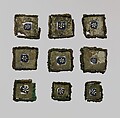Furniture ornaments
Not on view
These nine square blue glass plaques with six-petal rosettes were found at Arslan Tash, together with a large group of carved ivory furniture inlays. The glass plaques were probably also used to decorate luxurious furniture made of wood, ivory, or a combination of both. Each blue square is decorated with a white six-petal rosette, mounted into a reddish glass setting now oxidized to green, and framed by a corroded copper-alloy frame. Some of the white petals penetrate the blue squares and are visible on both sides, suggesting that the white petals may have been fused within the blue glass, perhaps in a manufacturing technique known as fused-mosaic glass. In this method of glass-working, threads of glass of contrasting colors are fused together to produce a long cane with a design in cross-section that is then stretched and sliced crosswise. The production of these pieces probably involved Phoenician craftsmen who were expert at inlaying colored glass into carved ivories. Several other small glass ornaments with rosettes, found at the Neo-Assyrian capital of Nimrud, are also in the Metropolitan Museum’s collection (58.31.43;58.31.44;62.269.15a-d).
Arslan Tash, ancient Hadatu, was an Aramaean town located in northern Syria just east of the Euphrates River, close to the modern Turkish border. French archaeological excavations at the site in 1928 revealed city walls and gates in addition to a palace and temple that were built when the Neo-Assyrian king Tiglath-Pileser III (744-721 B.C.) turned the town into a provincial capital and military outpost. During the excavations, over one hundred ivory furniture inlays were found in a building near the palace. Gold foil, paint, and semiprecious stone and glass inlay embellishments enlivened these magnificent works of art. Today, the ivories and decorative elements from Arslan Tash are housed in museums in Paris, Aleppo, Jerusalem, Karlsruhe, and Hamburg, as well as The Metropolitan Museum of Art.
Due to rights restrictions, this image cannot be enlarged, viewed at full screen, or downloaded.

